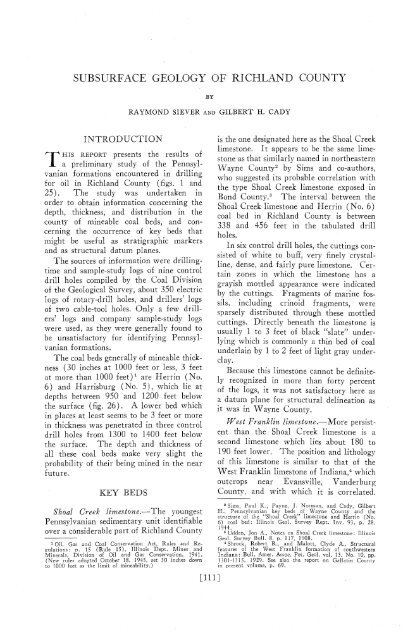subsurface geology and coal resources of the pennsylvanian system ...
subsurface geology and coal resources of the pennsylvanian system ...
subsurface geology and coal resources of the pennsylvanian system ...
Create successful ePaper yourself
Turn your PDF publications into a flip-book with our unique Google optimized e-Paper software.
A , . ..<br />
SUBSURFACE GEOLOGY OF RICHLAND COUNTY<br />
RAYMOND SIEVER AND GILBERT H. CADY<br />
INTRODUCTION<br />
HIS REPORT presents <strong>the</strong> results <strong>of</strong><br />
T a preliminary study <strong>of</strong> <strong>the</strong> Pennsylvanian<br />
formations encountered in drilling<br />
for oil in Richl<strong>and</strong> County (figs. 1 <strong>and</strong><br />
25). The study was undertaken in<br />
order to obtain information concerning <strong>the</strong><br />
depth, thickness, <strong>and</strong> distribution in <strong>the</strong><br />
county <strong>of</strong> mineable <strong>coal</strong> beds, <strong>and</strong> concerning<br />
<strong>the</strong> occurrence <strong>of</strong> key beds that<br />
might be useful as stratigraphic markers<br />
<strong>and</strong> as structural datum planes.<br />
The sources <strong>of</strong> information were drillingtime<br />
<strong>and</strong> sample-study logs <strong>of</strong> nine control<br />
drill holes compiled by <strong>the</strong> Coal Division<br />
<strong>of</strong> <strong>the</strong> Geological Survey, about 350 electric<br />
logs <strong>of</strong> rotary-drill holes, <strong>and</strong> drillers' logs<br />
<strong>of</strong> two cable-tool holes. Only a few drillers'<br />
logs <strong>and</strong> company sample-study logs<br />
were used, as <strong>the</strong>y were generally found to<br />
be unsatisfactory for identifying Pennsylvanian<br />
formations.<br />
The <strong>coal</strong> beds generally <strong>of</strong> mineable thickness<br />
(30 inches at 1000 feet or less, 3 feet<br />
at more than 1000 feet)' are Herrin (No.<br />
6) <strong>and</strong> Harrisburg (No. 5), which lie at<br />
depths between 950 <strong>and</strong> 1200 feet below<br />
<strong>the</strong> surf ace (fig. 26). A lower bed which<br />
in places at least seems to be 3 feet or more<br />
in thickness was penetrated in three control<br />
drill holes from 1300 to 1400 feet below<br />
<strong>the</strong> surface. The depth <strong>and</strong> thickness <strong>of</strong><br />
all <strong>the</strong>se <strong>coal</strong> beds make very slight <strong>the</strong><br />
probability <strong>of</strong> <strong>the</strong>ir being mined in <strong>the</strong> near<br />
future.<br />
KEY BEDS<br />
Shoal Creek limestone.-The youngest<br />
Pennsylvanian sedimentary unit identifiable<br />
over a considerable part <strong>of</strong> Richl<strong>and</strong> County<br />
10il. Gas <strong>and</strong> Coal Conservati?~~ .Act, Rules <strong>and</strong> Regulations:<br />
p. 15 (Rule IS), Ill~nols Dept. Mines <strong>and</strong><br />
Minerals Division <strong>of</strong> Oil <strong>and</strong> Gas Conservation, 1941.<br />
(New r;les adopted October 18, 1945, set 30 inches down<br />
to 1000 feet as <strong>the</strong> limit <strong>of</strong> mineab~llty.)<br />
C11-11<br />
is <strong>the</strong> one designated here as <strong>the</strong> Shoal Creek<br />
limestone. It appears to be <strong>the</strong> same limestone<br />
as that similarly named in nor<strong>the</strong>astern<br />
Wayne County2 by Sims <strong>and</strong> co-authors,<br />
who suggested its probable correlation with<br />
<strong>the</strong> type Shoal Creek limestone exposed in<br />
Bond C~untp.~ The interval between <strong>the</strong><br />
Shoal Creek limesto,ne <strong>and</strong> Herrin (No. 6)<br />
<strong>coal</strong> bed in Richl<strong>and</strong> County is between<br />
338 <strong>and</strong> 456 feet in <strong>the</strong> tabulated drill<br />
holes.<br />
In six control drill holes, <strong>the</strong> cuttings consisted<br />
<strong>of</strong> white to buff, very finely crystalline,<br />
dense, <strong>and</strong> fairly pure limestone. Certain<br />
zones in which <strong>the</strong> limestone has a<br />
grayish mottled appearance were indicated<br />
by <strong>the</strong> cuttings. Fragments <strong>of</strong> marine fossils,<br />
including crinoid fragments, were<br />
sparsely distributed through <strong>the</strong>se mottled<br />
cuttings. Directly beneath <strong>the</strong> limestone is<br />
usually 1 to 3 feet <strong>of</strong> black "slate" underlying<br />
which is commonly a thin bed <strong>of</strong> <strong>coal</strong><br />
underlain by 1 to 2 feet <strong>of</strong> light gray underclay.<br />
Because this limestone cannot be definitely<br />
recognized in more than forty percent<br />
<strong>of</strong> <strong>the</strong> logs, it was not satisfactory here as<br />
a datum plane for structural delineation as<br />
it was in Wayne County.<br />
West Franklin limestone.-More persistent<br />
than <strong>the</strong> Shoal Creek limestone is a<br />
second limestone which lies about 180 to<br />
190 feet lower. The position <strong>and</strong> lithology<br />
<strong>of</strong> this limestone is similar to that <strong>of</strong> <strong>the</strong><br />
West Franklin limestone <strong>of</strong> Indiana,4 which<br />
outcrops near Evansville, V<strong>and</strong>erbuq<br />
County, <strong>and</strong> with which it is correlated.<br />
Sims, Paul K., Payne, J. Norman, <strong>and</strong> Cady, Gilbert<br />
H., Pennsylvanian key beds <strong>of</strong> Wayne County <strong>and</strong> <strong>the</strong><br />
structure <strong>of</strong> <strong>the</strong> "Sboal Creek" limestone <strong>and</strong> Herrin (No.<br />
fbdyal bed: Illino~a Geol. Survey Rept. Inv. 93, p. 28,<br />
Wdden, Jon A., Notes on Shoal Creek limestone: Illinois<br />
Geol. Survey Bull. 8, p. 117, 1908.<br />
Shrock, Robert R., <strong>and</strong> Malott, Clyde A., Structural<br />
features <strong>of</strong> <strong>the</strong> West Franklin formation <strong>of</strong> southwestern<br />
Indiana: Bull. Amer. Assoc. Pet. Geol. vol. 13, No. 10, pp.<br />
1301-1315, 1929. See also <strong>the</strong> report on Gallatin County<br />
in present volume, p. 69.
















